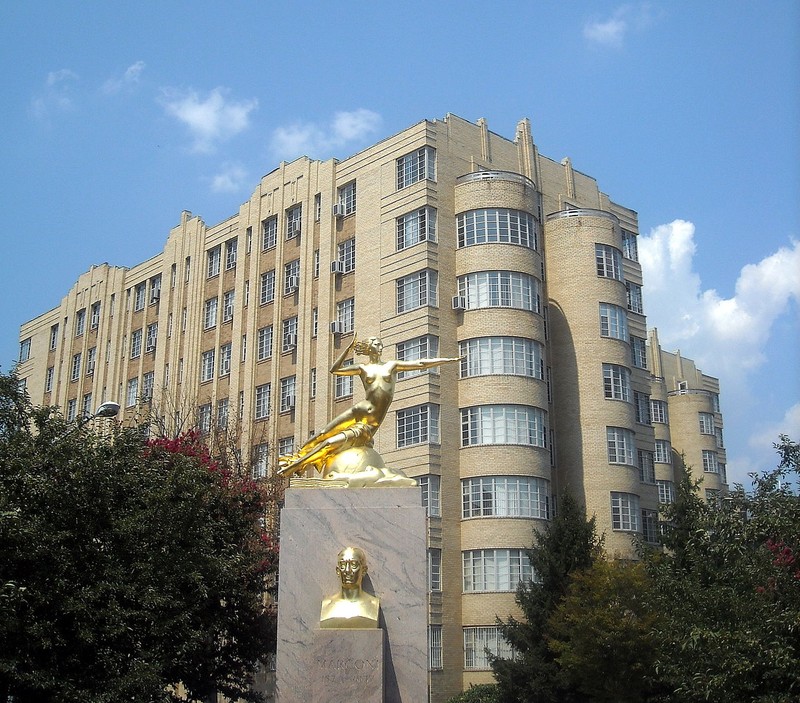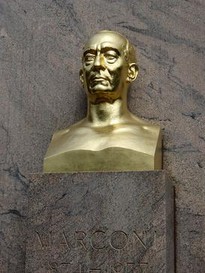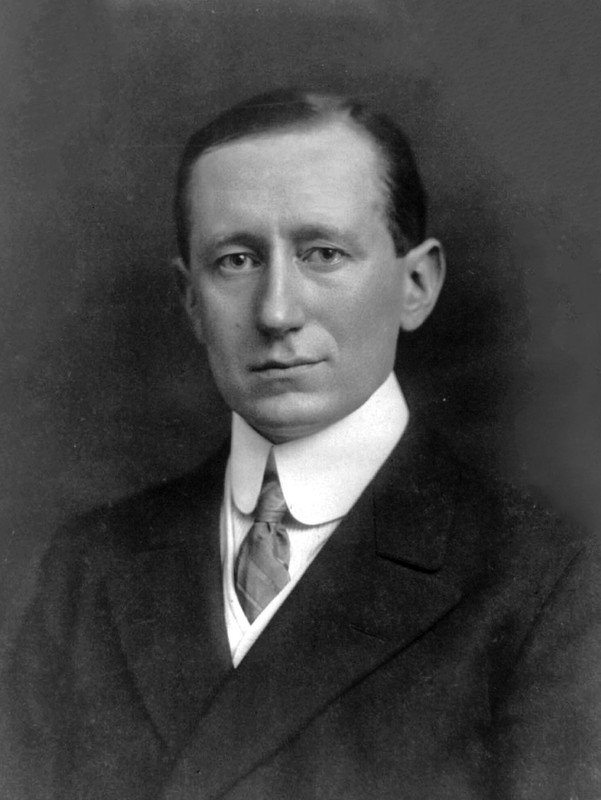Guglielmo Marconi Memorial
Introduction
Text-to-speech Audio
This memorial honors electrical engineer and inventor of the wireless telegraph, Guglielmo Marconi (1874-1937), whose work in the field of wireless telegraphy established the basis for radio communication. In 1901, Marconi was the first to broadcast a radio signal across the Atlantic Ocean from Cornwall in England to St. John's in Newfoundland, Canada. He shared the 1909 Nobel Prize in physics for his work with German scientist Karl Ferdinand Braun. The memorial consists of a granite base, a bronze bust of Marconi, and a bronze sculpture of a female figure sitting on a globe amidst clouds with her legs stretched backward. Her left arm points forward, her hair flows backward, and her right arm is bent at the elbow. Her posture, hair, and the drapery around her legs symbolize, according to the National Register of Historic Places nomination form, the "concepts of speed and dynamism." The memorial is a contributing property of the Mount Pleasant Historic District.
Images
Italian artist Attilio Piccirill created the memorial in 1941. It consists of a granite base, a bronze bust of Marconi, and a bronze sculpture of a female figure sitting on a globe with her arms stretched forward.


Guglielmo Marconi (1874-1937)

Backstory and Context
Text-to-speech Audio
Guglielmo Marconi was born on April 25, 1874 in Bologna, Italy to wealthy parents. His father, Guiseppe, was a businessman and landowner. His mother, Annie Jameson, was Irish and the granddaughter of John Jameson, the founder of Jameson & Sons whiskey company. As a boy, Marconi did not do well in school and was educated by tutors instead. He also lived next to physicist Augusto Righi (1850-1920), who studied electromagnetism and sparked Marconi's interest in electricity. As a teen, Marconi studied physics and electricity under the tutelage of his high school mentor Vincenzo Rosa. Marconi read scientific journals as well and learned about the discovery of radio waves by German physicist Heinrich Hertz. Marconi also learned about morse code around this time and showed an aptitude for technology.
When he was 18, Marconi attended Righi's lectures at the University of Bologna and was allowed use the laboratory and library of the university's physics institute. He studied the research of leading scientists of the day including James Maxwell and Hertz and conducted better experiments based on their work in electromagnetism. These efforts paid off for Marconi as he was the first to produce and detect radio waves. He also believed radio waves could transmit signals anywhere regardless of any physical obstacles. Most scientists believed that electromagnetic waves behaved like light waves, which are blocked by physical obstacles. Marconi's experiments demonstrated that this was false.
After studying at the university, he returned home to Bologna in 1894 and continued experimenting with radio waves. He was gradually able to send radio waves longer distances. In 1895, he made a breakthrough. He found that by raising his antenna he could send a signal 1.5 miles away. Convinced that he could send signals even farther, he applied for funding in Italy for his research but did not receive any. As a result, he moved to England in 1896 where he eventually patented his wireless radio (the world's first patent for a wireless telegraphy system). Over the next few years Marconi conducted more experiments and continued to expand the range of his radio. He also founded the first wireless telegraph company, the Wireless Telegraph and Signal Company, in 1897. In 1900, Marconi received another patent for "tuned or syntonic telegraphy) and, as noted above, sent the first transatlantic wireless signal from England to Newfoundland (2,100 miles), proving that wireless signals could be sent without being affected by the earth's curvature. In December 1902, a station Marconi built on Glace Bay, Nova Scotia was the first to receive a two-way transatlantic wireless message. In January, Marconi transmitted messages between President Theodore Roosevelt and King Edward VII.
Marconi's company was immediately successful and wireless telegraphs began to be installed on ocean vessels. However, the safety advantages of the new technology were not fully recognized until after the sinking of the R.M.S. Titanic in 1912. The ship was able to send SOS messages that were received by another vessel, the R.M.S. Carpathia, which was able to save a number of Titanic passengers. As a result, Marconi's fame rose around the world and wireless telegraphs were installed on more ocean vessels. During World War I, Marconi became a lieutenant in the Italian army where he led the military's radio service (he eventually transferred to the navy and earned the rank of commander).
In the coming decades until his death in 1937, Marconi continued to research and experiment. His short wave radio system was adopted by the British government in 1926 to establish a communication link between England and Canada. In 1932, the world's first microwave radiotelephone link was installed between Vatican City and the Pope's summer residence. Three years later, Marconi demonstrated of an early version of radar.
He died in Rome on July 20, 1927 of a heart attack. In addition to the Nobel Prize, during his career Marconi received numerous awards and honorary doctorates. Among these was being appointed an Honorary Knight of the Grand Cross of the Royal Victorian Order in England. He married twice and had three children, a son and two daughters. The memorial was added to the National Register of Historic Places in 2007.
Sources
Barsoum, Eve L. "Guglielmo Marconi Memorial." National Park Service - National Register of Historic Places Nomination Form. October 12, 2007. https://s3.amazonaws.com/NARAprodstorage/lz/electronic-records/rg-079/NPS_DC/07001057.pdf.
"Guglielmo Marconi." The Nobel Prize. Accessed November 10, 2022." https://www.nobelprize.org/prizes/physics/1909/marconi/biographical.
https://s3.amazonaws.com/NARAprodstorage/lz/electronic-records/rg-079/NPS_DC/07001057.pdf.
"Guglielmo Marconi." Scienza Giovane. Accessed November 10, 2022. http://www.scienzagiovane.unibo.it/English/scientists/marconi-1.html.
Smith-Rose, Reginald Leslie. "Guglielmo Marconi." Britannica. Last Updated September 29, 2022. https://www.britannica.com/biography/Guglielmo-Marconi/Major-discoveries-and-innovations-in-long-distance-communication-and-shortwave.
Reinman, Paula. "The Discovery that Continues to Change the World." The Marconi Society. October 13, 2016. Retrieved from the Web Archive on November 10, 2022. https://web.archive.org/web/20191003014822/http://marconisociety.org/marconi-biography.
"What is radio communication." Scienza Giovane. Accessed November 10, 2022. http://www.scienzagiovane.unibo.it/English/scientists/radiocommunication.html.
All images via Wikimedia Commons: https://commons.wikimedia.org/wiki/Category:Marconi_memorial_Mount_Pleasant
